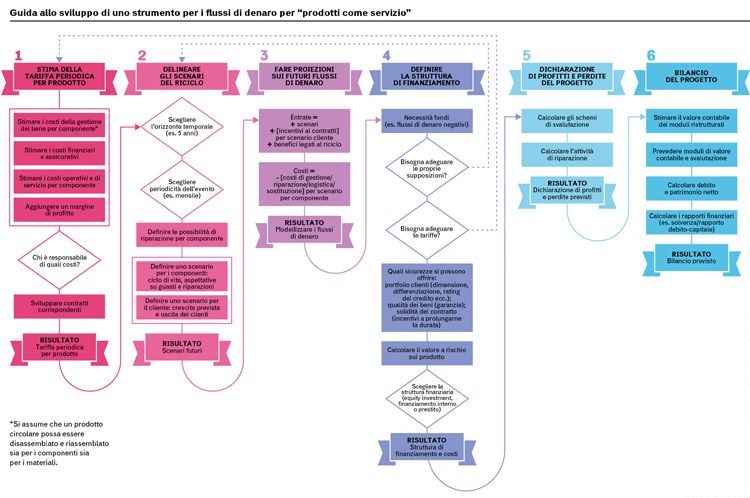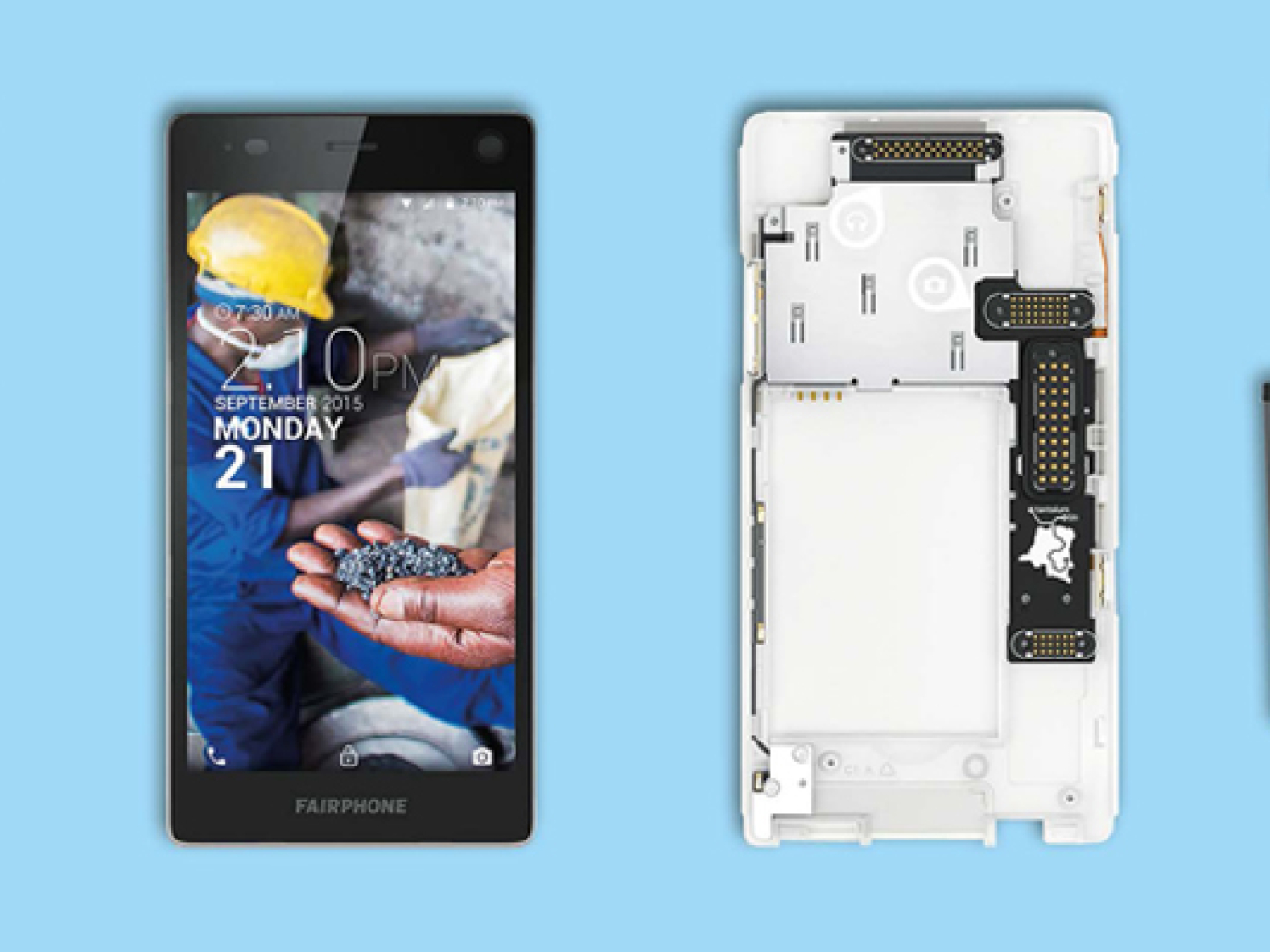While the circular economy is gaining momentum all across the world, the urgency to develop and implement viable circular business models is crucial to its success. One business model that is very promising for the circular economy emphasizes use rather than ownership of a product by providing a service rather than a product. Companies that apply such a Product-as-a-Service model retain ownership of their products, and are incentivized to create high-quality, durable products and to collaborate with their supply chain partners, while customers enjoy the performance of a product without the hassle.
Businesses striving to implement Product-as-a-Service models, however, have trouble attracting funding due to shifting value, ownership and governance needed to secure funding. Plus, it has proven to be very complex to create a financial model for Product-as-a-Service models, especially when the product involved has components that can be cycled infinitely. Businesses often lack the expertise to provide financiers with the financial impact of their circular business model, leaving them unable to convince financiers of its soundness. This lack of a proof leaves financiers guesstimating the risks and hesitant to take the plunge. Additionally, the current financing, legal and accounting standards are not equipped to fairly interpret circular risks and opportunities. But if nobody jumps into the deep end and finances one of these innovative business models, a benchmark will never be created.
This is where Sustainable Finance Lab, Circle Economy and Fairphone saw the urgent need to bridge the gap between financiers and circular entrepreneurs. In a Community of Practice all elements and tools needed for Product-as-a-Service models to flourish were co-created: an open and diverse community, a durable circular product, a financial model, and a sound contract. This way, the community has proven that the gap between the businesses and financiers is much smaller than initially thought. All learnings in the form of a white paper, the Circular Service Contract template and a guide to developing a financial cash flow tool are provided open source.
An open (source) learning community
Overcoming barriers to circular business models requires open collaboration and transparency to create synergies between different fields of expertise (business, legal, operational, financial). This led to the joining of forces to create a unique interdisciplinary Community of Practice with Sustainable Finance Lab, Circle Economy, Fairphone, PGGM, ING, ABN AMRO, NBA, Allen & Overy, and Circularise. Made possible by Nederland Circulair! who invested in the Community of practice, and all other CoP-partner organisations that co-invested in the learning experience.
Connecting partners who are motivated to share their expertise and collaborate is key for overcoming the barriers and taking the next steps in creating Product-as-a-Service business models. The business model was explored in much more detail than has been done before by zooming in on questions such as: What exactly should the value proposition be? How can this be captured in a contract? What are the financial implications thereof? And what financing structure suits the Circular Fairphone Service best? These questions could not be answered in isolation; for instance, framing the value proposition, setting the contract length and monthly fee remained unclear until the very end of the project. Only after extensive multidisciplinary discussions – thanks to the expertise of the CoP partners – the answers emerged and the pieces of the puzzle fell in place. Hence, it is important to stress an open learning process to connect the dots on the content side and enable cross-disciplinary synergies.
Fairphone: a durable and modular product
In business models that provide a service rather than a product, service providers retain ownership of products, and revenues are based on the performance of the product. This incentivises the offering of high-quality, durable products that can be easily upgraded, repaired, and taken back at the end of their useful life. The Fairphone, well-known for its ethically sourced materials and designed for modularity, optimises value creation based on the lifespan of its individual modules rather than the entire device. A substantial cost saving can be made because individual modules can be taken out for maintenance, repairs and recycling. This way, the lifetime of modules can be extended by leaving functioning modules in while only replacing the module that needs maintenance or repair. The modular design of the Fairphone proved very well suited to implement the Circular Fairphone Service proposition.
In order to fully unlock circular value, however, new operational processes must be implemented. State-of-the-art hardware management is critical to optimise the use of individual modules, ensure high quality services and maximise circular value. Additionally, the access to and use of user data is critical, for example to enable Fairphone to conduct preventive maintenance, yet has to be carefully balanced with privacy considerations.
A robust but flexible circular service contract
Product-as-a-Service radically transforms customer relationships from a one-off transaction to an ongoing service engagement. Service specifications must be clearly delineated, risks need to be fairly allocated to parties best able to handle them and translated into a contractual agreement that reflects needs for flexibility and continuity. For Fairphone, it is key to offer an appropriate level of technology while taking into account circular economy considerations.
The level of technology offered in the service and strategies to cover for the risk of termination of this contract were discussed in-depth. Promising to provide the latest technology could reduce circularity, on the other hand to keep engaging clients the value proposition should be attractive and up-to-date. Scoping the service in terms of “generally accepted technology” seemed to provide a good middle ground. This way, Fairphone has the right and responsibility to consider both functionality and sustainability aspects.
The power of numbers
Developing a financial cash flow model is essential to gain insight into the effects of a Product-as-a-Service business model on financial ratios and financial statements: balance sheet, profit- and loss statement and cash flows. However, modelling financial statements on module level is difficult. The financial cash flow tool that was made for the Circular Fairphone Service helped to get out of a deadlock of businesses lacking the numbers behind their PaaS models and financiers being reluctant to invest. Modelling complex PaaS models is specifically difficult because modules can be cycled many times. This requires future expectations about returning and re-using cycles and lifetimes of modules. It also requires a sound estimation of the monthly fee based on expected costs from providing the service, handling of modules, insurance, finance and other operations.

The monthly fee combined with expectations on returning and re-using modules provided a basis to project cash flows, profits and the balance sheet into the future. Given the assumptions, cumulative cash flows became positive over time, and the investment need for the Circular Fairphone Service proved to be relatively limited.
From modelling the balance sheet on module level, it became clear that it is imperative to have a data management infrastructure in place to track and trace modules to be able to monitor and value them. Without this, it is impossible to activate the different modules on the balance sheet during their cycles, based on different lifetime expectations. What specific accounting regulation is needed for circular business models such as the Circular Fairphone Service are (yet) unclear and what effects “circular depreciation” has on fiscal benefits from “fast depreciation” will need to be explored.
Provided the results of the cash flow projections, the solution for financing the Circular Fairphone Service lies in combining the flexibility of a current account credit with a more predictable financial relationship of lease structures, while underwriting these with key strengths, such as client quality (diverse and predictable portfolio), asset quality (good quality phone with modularity) and the cash flows (a portfolio of contracts). The potential lack of a resilient portfolio of clients in the start-up phase can be compensated with a termination fee (decreasing over time) that covers the remaining value at risk on the asset in the event of liquidation of a contract. For FaaS a termination fee may not be needed, since Fairphone 2 devices have a high value on second-hand and refurbished markets.
The financial CoP partners expressed dedication to tweak existing structures to find a final structure for this pilot. The approach taken for Fairphone can easily be adapted and replicated for other businesses. The flowchart details the steps needed to develop a cash flow tool for a circular Product-as-a-Service model.
Dare to envision new business models to truly transform our economic rationale
This journey enabled to overcome several barriers that Product-as-a-Service poses. Insights were provided into the characteristics of a modular product, the corresponding financial effects, and the strength of a flexible yet robust Circular Service Contract. These outcomes are relevant for both the business community that seeks to continue its journey towards circular business models and financiers that want to understand the changing risks and opportunities of these business models.
Although Product-as-a-Service business models are cornerstone to a changing economic rationale and very promising for a transition towards a circular economy, they may not work for all product types or market segments. Please feel invited to have a fresh look at your own business, and challenge yourself to rethinking economic incentives for circularity in your own market. Dare to envision new business models and organisational structures to truly transform our economic rationale.
A blueprint of a viable business model for the Circular Fairphone Service was co-created by the Community of Practice. Following the open source ethos, all learnings in the form of a white paper, the Circular Service Contract template and a guide to developing a financial cash flow tool are provided open source and can be downloaded online. Fairphone is currently exploring opportunities to start a pilot project to offer the world’s first Circular Fairphone Service for Companies.
If you are interested to participate in a pilot as an expert or to transform your own business into a circular one, please contact Circle Economy. If you are interested in providing your employees with the most circular phone in the world, please contact Fairphone.
By publishing the learnings and results of our journey we aim to provide the necessary tools and inspiration to create sound Product-as-a-Service business models. The knowledge we gained is for sharing, modifying and experimenting. Enjoy!
Sustainable Financial Lab, sustainablefinancelab.nl/en
Circle Economy, www.circle-economy.com
Fairphone, www.fairphone.com/en
Report “The circular phone”, www.circle-economy.com/the-circular-phone


